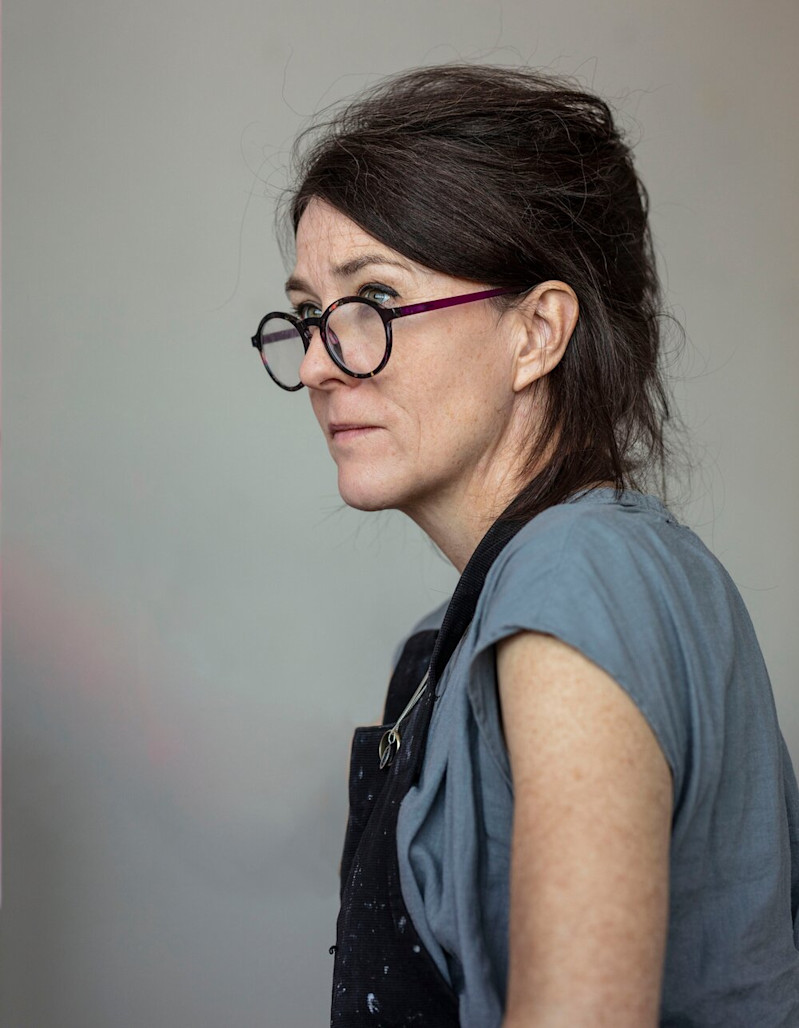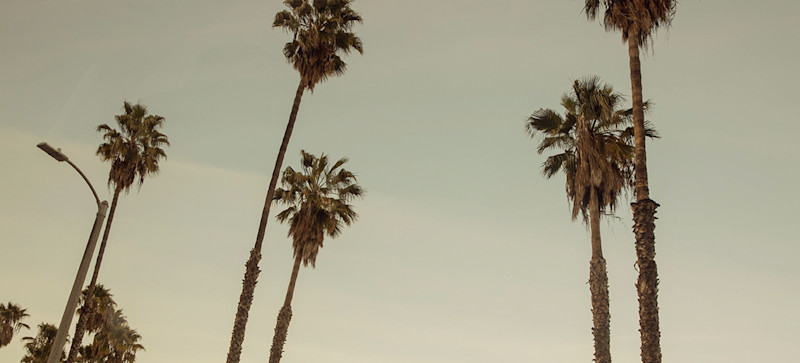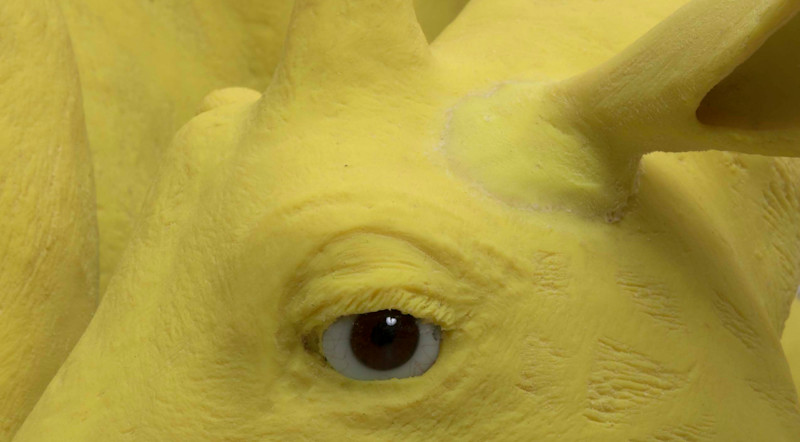Martina Müntzing, How Fast Your Heart is Pounding in Me
Essay
November 29, 2020
- Jonas Gardell

Martina Müntzing, Farväl till en utsikt, 2020, Oil on canvas, 206 x 271 cm
When I visit Martina in her studio, the dominant painting is a large canvas, a paraphrase of Richard Bergh’s iconic work Nordisk sommarkväll [Nordic Summer Evening], in which a man and a woman gaze out over the reflective surface of a lake in the dusk. In Martina’s version, she and her husband Lars are the couple, and the beautiful summer evening has been replaced by a day shrouded in a near-white haze that makes everything seem absolutely still.
It’s October of 2020, the strange, disquieting year when everything we called reality came undone.
Our existence is in a state of flux. Time has been extended in an odd way. It’s only been eight months, but it feels like a lifetime. Even remembering the time before is difficult, as is imagining a time after. All the things we took for granted, all the things we counted on, presumed, and planned around are suddenly no longer valid, and none of us know how long this flux will go on for, this sense of unreality. When we will stop drifting around.
Nor do we know what the world will be like when the fog finally lifts.
If it ever does, that is.
Martina’s studio is in an industrial estate, not far from Södermalm, but once I’ve cycled across the bridge to Årsta, the GPS directions I’m listening to in my earphones get confusing. Rather than continuing straight ahead, which seems the reasonable way to go, I’m instructed to take a right turn, onto some strange little forest roads in a common by a newly developed residential area. Not even roads, really–asphalted and gravelled footpaths would be more accurate.
After this, the GPS navigator sends me alerts repeatedly, like it always does when you’ve taken a wrong turn and it has to correct the route and feed you new instructions: go right along such-and-such a road, then left on such-and-such a road–ding–go left–ding–go right. But there are no road signs in this grove. I can’t tell if it’s this particular little asphalted stretch or that gravel path that the GPS system is referring to, so I ride around at random–right, left, right, left, down a slope, change my mind and pedal back up the slope–without any real direction or clue what I’m doing or where I’m going.
And so, suddenly, I’m clear of the little wooded area, and back on a real road, with pavements, cars, and bicycle lanes. Ahead of me, downhill from me, I see an industrial estate. I think to myself that the place I’m going to must be somewhere there, and take a chance on cycling that way. Suddenly, the GPS system alerts me again, and the computer’s voice tells me, “you have reached your destination.” (A statement which, if we’re being honest, is always something of an existential exaggeration coming from a GPS navigator).
After meeting me at the entrance, and advising me to bring my electrical bike’s battery inside, to make sure it won’t get stolen, Martina leads me up to her studio, where she sets out the paintings she will be showing at her coming exhibition.
Apart from the paraphrase of Nordisk sommarkväll and a large, as yet unfinished painting depicting Martina’s family in the act of building snowmen together, there are five paintings, about two meters in height and one meter across, which are dominated by peculiar pink, artificial hues.
Each of these tall, narrow, pink paintings portrays a solitary teenager, standing or sitting, and leaning against a tree trunk in a veiled woodland setting, which is mostly just hinted at. There seems to be a fog brewing.
The kids are alone, abandoned in the desolate pinkness. Perhaps this is a forest in which there is no obvious way out.
It brings to my mind the forest of enchantment and identity shifts of Shakespeare’s A Midsummer Night’s Dream, to Chekhov’s birch and cherry trees in a world on the brink of collapse–but also, to the little wooded area nearby, where I was just cycling around with the feeling of being completely, utterly, lost.
Throughout her oeuvre, Martina has painted her children, Olle and Elsa, always with a hint of the mournful.
It’s as though she knows that the act of painting her children represents an attempt to freeze time, and that this is doomed to failure; she’s trying to capture her children in mid-flight, in vain.
Because our children’s trajectories always carry them away from us.
Making these paintings is time-consuming–sometimes it can take years for a work to be finished, by which time her children are already different people than the ones they were when she started painting.
Now, they’re almost grown up.
It’s the same with my own children. My eldest has just turned 18, and I’m no longer his legal guardian. I was unprepared for the sadness this would bring me, a sense of something coming to an end without my realising it.
We are adrift in a landscape of loss.

Next, I return my eyes to the largest painting. The one where she and her husband are gazing out over the water in the white haze.
They arrived here. To this white water. Where their road ended. I know her husband died earlier this year. Martina explains to me that Lars was modelling for her, but things took a turn: he fell ill, and passed away before the painting was finished. She wasn’t done. And now, she can’t bring herself to continue painting him. She’s tried, but she can’t. His body: his jacket, his jeans were never finished. He is a Lars that can no longer be painted. A Lars that never got done. Or, one that would have to be done like this. Half-way. She herself is fully painted; possessing weight, sharpness, and detail. He, on the other hand, is translucent. Apart, that is, from his face, the one that is watching hers. Sincerely, lovingly. Like somebody who by virtue of their absence will be forever present. And I think of my husband Mark’s mother, who also passed away from cancer just a few months ago, last spring, during Finland’s near-total lockdown. Mark was on Åland, waking at his mother’s deathbed, and unable to come home. I was in Stockholm, unable to go to Åland to be by his side. Everything froze somehow. Nobody got to say goodbye properly; the funeral was held on Facebook. It was all quite miserable. Mark would later describe to me how he had left the hospital room for a moment, to stretch his legs and get some air, and walked out into a deserted, completely halted Mariehamn; it was as though his own inner desolation was perfectly aligned with the city’s.
Next, I notice that in Martina’s picture, there is a little dead sparrow next to her feet.
A remarkable coincidence, because the very evening before visiting Martina’s studio, I gave a sermon in a church about the strange times we live in, where everything is in flux and dissolving, all the things that were only recently anchored and secure. I also spoke of the fact that we’re about to enter the darkest months of the year, without even knowing if we’re properly prepared for them, whether we’ll manage to face darkness and the winter.
I told the congregation about when I was 14 years old, at a Christian youth camp, and received word of a sudden death in the family. I hadn’t been able to tell anybody at the camp, neither the staff nor any of my friends, so instead, I went down to the water some distance from the camp grounds and sat down on a rock, and while I sat there in solitude, in a reality that had been distorted and turned into unreality, I began to sing a verse of a hymn we’d learned at the camp that week:
Not a sparrow falls to Earth
Without God’s knowledge.
Not a soul to death
Without His love.
Not a rose has withered.
Not a tear has been shed.
Without God’s knowledge of it.
For He is everywhere.
That summer evening, when word reached me of this death, I clung to these few lines, and sang them, stubbornly, doggedly, over and over, time and time again, all the while staring ahead, out over the water: Not a sparrow to Earth without God’s knowledge. Not a soul to death without His love. Not a sparrow to Earth without God’s knowledge. Not a soul to death without His love.
I felt like I would drown if I stopped singing; fall and never get back up again.
And I see that dead, little sparrow at Martina’s feet, but then, I raise my gaze, and it’s only now that I see that Lars isn’t looking out over the water, like the man in Richard Bergh’s painting.
Martina herself has fixed her gaze on the distant haze, where the water appears to be opening up, and brightening, staring at that which must somehow go on, despite the fact that everything that exists has ceased to be.
He, though, has turned his face towards her, and is looking at her with love, and perhaps, by virtue of his absence, he will be forever present.
Before I leave, Martina gives me a book of poetry, Any Case by Wislawa Szymborska, and tells me that I might enjoy it; she has two poems in particular in mind.
I open it and read the poem “Parting with a View”:
I don't begrudge the spring
for coming back again.
I can't blame it
for doing its duty
the same as every year.
I realize my sorrow won't halt the greenery.
If a blade wavers,
it's only from the wind.
It’s breathtakingly beautiful and sad.
Inside the studio is one last, as yet unfinished, painting that she intends to get done for the exhibition.
Here, the whole family is gathered. Lars, Olle, Elsa, and herself. It’s winter, and they’ve gone outside to make snowmen.
This time, perhaps because this is as far as she’s got, the only part of the painting that she’s finished painting is the four snowmen.
It’s usually the other way around: sketched scenery with the members of the family laboriously completed.
Now, instead, it is the children, her husband, and herself that are mere pencil outlines, left transparent. Deeply focused on the task of making snowmen. And here’s where the remarkable thing happens; precisely because the family is “only” drawn in pencil, precisely because they are transparent, they become translucent, like spirits.
Eternal, somehow.
They will be forever together as a family.
They will be forever deeply focused on building their snowmen.
Like a group of people who by virtue of their absence will be forever present.
Forever ongoing.
When I leave the studio to cycle home again, I don’t bother with the GPS navigator. It has no idea where we are, anyway. We’re abandoned to ourselves, somehow. We carry on, even when we can’t see how to carry on.
Everything is in a state of flux. The children grow up. Our loved ones disappear from us. Nothing is the way it’s supposed to be. All the things we took for granted, all the things we counted on, presumed, and planned around are no longer valid, and none of us know how long this flux will go on for, this disquieting unreality that has become our reality now.
But at our feet lies another little sparrow, reminding us that we’re not yet fully and totally abandoned. Someone has turned their face towards us, and looks down on us with love. There are moments that we will always carry with us; moments we share with our loved ones, in work and in play. So, we carry on, together. It’s almost like a miracle. A miracle of love. When I get back home, I sit down with Szymborska’s poetry collection. Read the first poem. The one called “Any Case”.
I couldn't be more bewildered, bemuted by this.
Listen, how fast your heart is pounding in me.



